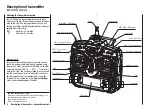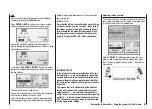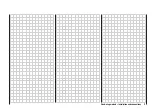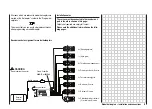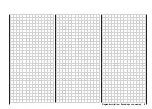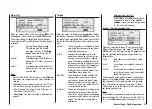
25
Assigning switches and control switches
The basic procedure
At many points in the program there is the option of
using a switch (SW 1 … 4, SW 6/7, PB 8) or a cont-
rol switch (G1 … 3; see below) to operate a function, or
to switch between settings, such as the DUAL RATE /
EXPO function, fl ight phase programming, mixers and
more. The mx-16s allows you to assign several functions
to a single switch.
The process of assigning switches is exactly the same in
all the relevant menus, and we will explain the basic pro-
gramming procedure at this point so that you can con-
centrate on the special features when reading the de-
tailed menu descriptions.
A switch symbol appears in the bottom line of the screen
at all programming points where switches can be assi-
gned:
If you move to this fi eld using the right-hand rocker but-
ton, the switch symbol fi eld is highlighted (inverse video
– black background):
The procedure for assigning a switch
1. Press the
SELECT
button.
The following message appears in the display:
2. Now simply move the switch you wish to use to the
“ON” position, press the push-button, or move the
C1 stick from the “OFF” position in the direction of
“ON”. Please note: the so-called control switches as-
signed to this transmitter control (see right) carry out
the task of an ON / OFF switch in software; the same
applies to the throttle limiter (see page 54) which is
available in the “Helicopter” model type. This comple-
tes the assignment process.
3. Changing the direction of switching:
If the switch turns out to work in the wrong direction,
you can correct it as follows: move the switch to the
desired OFF position, select the switch symbol once
more and assign the switch again, this time with the
switch direction you prefer.
4. Erasing a switch:
Activate the switch symbol as described under Point
2, then press the
CLEAR
button.
Special feature: SW 4 / PB 8
This “push-button” can be assigned in two ways:
• A brief press as On / Off switch “4”, i.e. the switched
state (“on” or “off”) changes every time you press the
button.
• A longer press as momentary button “8”, i.e. the
switch is only ON as long as the button is held
pressed in.
Note:
Every time you switch the transmitter on, switch 4 al-
ways defaults to the “OFF” position.
Transmitter control switches
Many functions are best controlled automatically by
a particular (freely programmable) position of the C1
transmitter stick (or the throttle limiter in the case of heli-
copters), rather than by a conventional physical switch.
Typical applications:
• Automatically switching an on-board glowplug energi-
zer on and off according to the throttle position of the
C1 stick (“G1” or “G2”). In this case the switch for the
plug energizer is controlled by a mixer at the trans-
mitter.
• Automatically switching a stopwatch on and off to re-
Description of transmitter – switch assignment
cord the pure “fl ight time” of a model helicopter; this
is accomplished using the “G3” switch of the throttle
limiter.
• Automatically switching the “AIL
RUD” mixer off
when the airbrakes are extended, in order to keep the
wings parallel with the ground when landing on a slo-
pe face, without the (usually coupled) rudder affec-
ting the model’s heading.
• Automatically extending landing fl aps with coupled
elevator trim adjustment on the landing approach,
as soon as the throttle stick is reduced below the set
threshold point.
• Automatically switching a stopwatch on and off in or-
der to time the run of an electric motor.
For both model types the mx-16s transmitter’s softwa-
re caters for these purposes with two “control switches”
of this type; they can be assigned to the C1 stick: “G1”
is switched on at around -80% of full travel, while “G2”
is switched on at 80%. The Helicopter program
also includes an extra control switch “G3” on the throttle
limiter close to the 100% point; see page 54.
All these control switches can be included without re-
striction in the free programming of the switches, i.e.
they can be assigned to a function instead of a physi-
cal switch. This means that you are able to assign one of
the control switches G1 … G2 (or G1 … G3) instead of
a physical switch at any point in the software where swit-
ches are assigned. All you have to do is move the C1
stick or the throttle limiter control (by default the rotary
proportional control CTRL 7) from the desired “OFF” po-
sition in the direction of “ON”.
Summary of Contents for MX-16S
Page 1: ...1...
Page 17: ...17...
Page 31: ...31 Fixed wing models Installation and connections...
Page 35: ...35 Program description Reserving a new memory...
Page 47: ...47 Base settings Model helicopter...
Page 83: ...83 Fail safe...
Page 89: ...89 Programming examples Fixed wing model...
Page 109: ...109 Programming examples Model helicopter...
Page 112: ...112 112...
Page 116: ...116...




